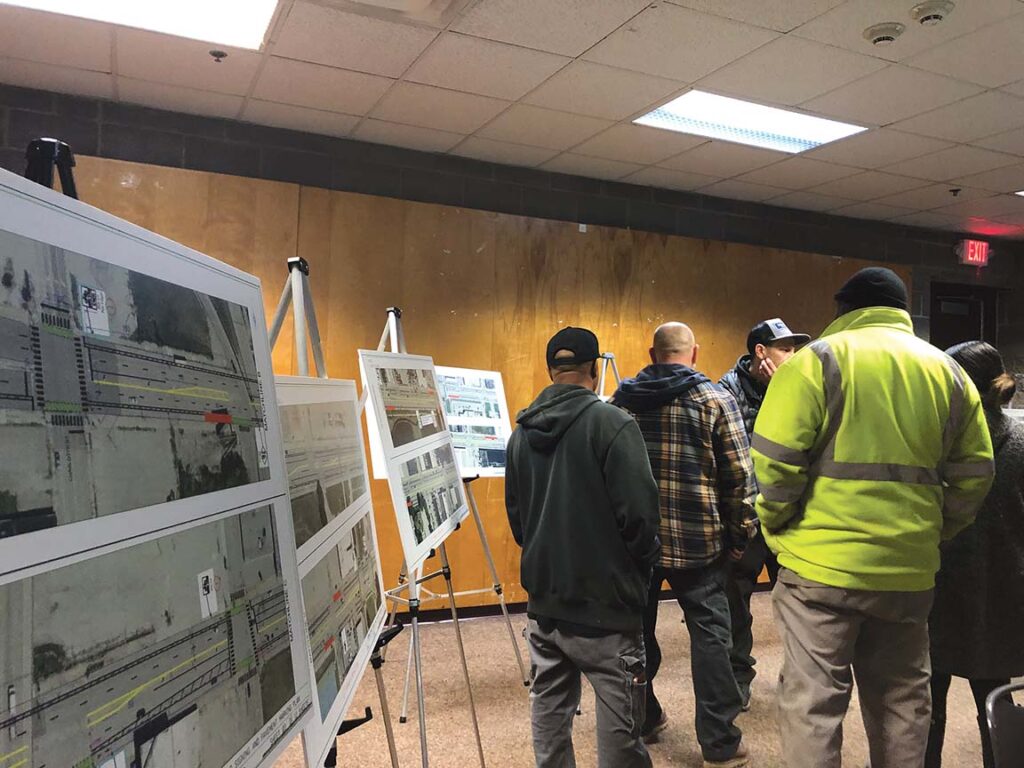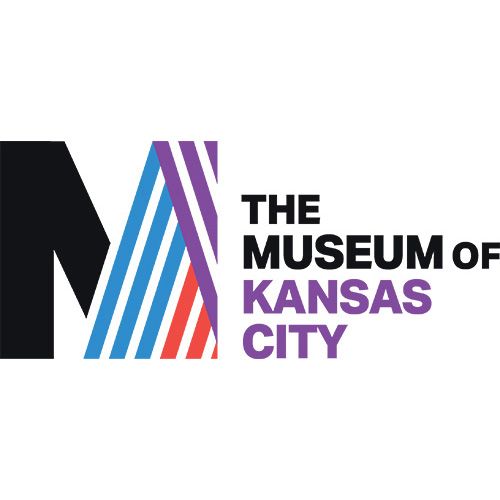
Dorri Partain
Contributor
Following a January 6 listening session about the protected bike lanes recently installed on Truman Road, the Kansas City Public Works Department hosted an additional session on Wednesday, Jan. 18, to address those concerns and offer solutions.
Community members and business owners gathered at Gregg/Klice Community Center, 1600 E. Buck O’Neil Way, as Public Works Director Michael Shaw presented solutions based on concerns about the loss of parking, loading and unloading designations, and signage.
He began by explaining how and why Truman Road was chosen.
Truman Road was considered for the project due to the Complete Streets study, which measured safety on the seven lane road, because it was designated a “high injury network” road.
“What that means is that Truman Road has more lanes than cars that actually drive on it, and that there’s not enough cars to support a seven lane road,” Shaw said. “We knew, as a matter of practice, as we talk about designing infrastructure, you have to build infrastructure based on the density, capacity, which is on the road. One of the challenges with Truman Road is how fast people drive on the road. It’s a wide open road – again, seven lanes – so the challenge becomes, how do you right size the infrastructure for the cars that are actually on the road?”
Shaw said his department has an absolute responsibility to reduce traffic accidents and crashes on City roads.
“Bike lanes are the tool to be used in order to reduce the number of lanes that are on Truman Road,” Shaw said. “So I’m not here to pick sides, cars versus bikes. I’m here to tell you that the bike lane is the tool used in this scenario.”
The department had two options to reduce the number of lanes on Truman Road, Shaw said. They could have infilled it and put in curbs all the way down, taking out two lanes on either side, or they could have put in a bike lane, keeping the infrastructure so that as the corridor again grows, they have the infrastructure already there.
“You can remove all that and you continue to have the infrastructure,” Shaw said. “There are costs that are associated, either direction. Utilizing bike lanes in this case is a more cost efficient way to meet those ends.”
To present the suggested solutions, Jason Waldron, Public Works Director of Transportation, was handed the floor.
“We’ve got basically six areas that we were able to focus on and come up with different ideas to address your comments: parking, safety and speed, have access and deliveries, traffic operations, and then snow and emergency operations,” Waldron said.
What they proposed is, rather than a time restricted parking lane, they would go ahead and protect it and make it a permanent parking lane.
“So that way, rather than having parking on certain times of the day, you get parking up and down the corridor permanently, all times of the day,” Waldron said. “As you know, the existing condition was the time restricted, with a bike lane buffer. Again, this would be a permanent protected bike lane, we would add additional signage, and we would also make a solid pavement marking so people really understood that this was a parking lane, that would give you that volume of parking that you need, and also provide additional safety with the protections.”
At each end of the block it would be barricaded so drivers could not drive through the bike lanes anymore, at any time of the day. For this plan, the type of signage to be utilized is still being discussed.
With the reduction of lanes, from seven to four or five, there would be a reduction of traffic flow.
“Twice a day at peak hours, you’re going to see a little more congestion at some of the intersections – and that might be waiting an additional cycle at a traffic signal – what we get out of that, the speeds go down, the crashes go down and the fatalities go down,” Waldron said. “That’s just the trend, you can look that up. Speed is the number one direct factor of accidents and the severity of those accidents.”
He offered a plan to give certain businesses access for delivery vehicles, a common complaint of the business owners who said they were not heard during the planning process.
“We definitely heard at two different locations of where we could use a loading zone,” Waldron said. “So what that would be is permanent access for deliveries and loading in those spaces. We would go ahead and remove the bike lane protection so it would be kind of a shared space between those deliveries and bicyclists. We don’t have it totally worked out, but we feel very comfortable that’s something that we can offer.”
In reference to many of the complaints about confusion for drivers, he explained, “You’re going to see different areas where we did redesign, with pavement markings and things like that, and then we do agree there can be some additional signage out there to help all roadway users, pedestrians, bicyclists, autos, you name it. One thing we would like to say is we also want to complete what we have out there, because anything that’s incomplete does lend itself to some confusion.”
As Waldron wrapped up his presentation, he addressed the final concern from the previous session.
“The last thing that we heard was some concern over emergency vehicles,” Waldron said. “We talked to our fire and police departments, this lane configuration would not even be close to the worst in the city, so we feel pretty comfortable that this would not impede any kind of emergency vehicle access.”
As attendees were given the opportunity to ask questions or comment about the proposed improvements, the comments focused more on difficulties around the city where bike lanes have already been installed. From north of the river near Zona Rosa, to Armour Boulevard and Gillham Road, commenters shared their continued concerns about sightlines from navigating around cars parked next to protected bike lanes while driving, walking dogs, or pushing a baby stroller. Concerns about the visibility of bikers and their safety was shared by drivers, and issues of feeling safe while riding a bike in unprotected lanes were shared by cyclists.
As excessive speed and need to reduce lanes continued to be mentioned, one attendee asked about enforcement of the speed limit.
“If there’s such a speeding problem, I bet if we made a deal with the police department, then you keep all the money from speeding tickets, that will slow that traffic down in a heartbeat,” the commenter said. “And you can get the people their parking back, which is critical to their business.”
To that, Shaw remarked that that suggestion would need to be directed to the police department, which was not present at the meeting.
Business owners in attendance appeared to be unhappy regarding the proposed solutions, holding up signs as comments were traded back and forth.
Shawn Arcedino, a strong opponent of the bike lanes who owns a collision repair shop at 2712 Truman Rd., remarked, “You’re suggesting we take the lane of traffic, cut it in half. So if we could send 10 balls down the track, we’re not going to cut in half. You only get five. What’s that do to the economy? It cuts it in half. So you’re saying you want safer streets but what you’re giving us is less money, you’re giving less to customers, less support, and car wrecks.”
Two weeks ago, Public Works said they were going to put signs up immediately, Arcedino said.
“Three days later, we had a guy smash a parked car,” Arcedino continued. “He had a, I think, 11-month-old baby in the back of his car, totaled out the car he hit and totaled out his car. Why did he do that? Because he’s driving down for a mile and a half, doing 40, whatever the speed limit is, and BAM, there’s a car in his lane. No signage, there’s nothing to say, ‘Hey, there’s a car coming up, move over.’”
The question of who was consulted when designing the bike lane “road diet” was brought up and whether those guidelines were those set by NATCO, the National Association of Transportation Coordinators. Waldron responded that several sets of guidelines were used to develop their own guidelines.
The Truman Road Complete Streets Plan was introduced in 2018 by the City of Kansas City and Mid-America Regional Council (MARC). Consultants in developing the plan were Alta Planning + Design, Parson & Associates, and Bike Walk KC. That study concluded that a road diet along the Truman Road corridor would naturally reduce street speed and would provide opportunities for installing additional pedestrian supportive measures. Reduced traffic speeds are desirable, according to the study.
“This corridor, east of the downtown area, will be inviting to high volumes of pedestrians with increased infrastructure for pedestrian safety in addition to enhanced low stress bikeway connectivity,” the study reads.
In an effort to conclude the session peacefully, as tempers flared Shaw said, “I want to say this for all our bicycle folk out here, as much as you don’t want to be a minus because you ride bikes on bike lanes, don’t admonish people who have cars. So it ain’t about whether you have a bike or you have a car. This isn’t about bike lanes. I don’t want to get into this, ‘I got a bike, this vehicle is a deathtrap.’ I don’t want to hear all that stuff. That’s not what this conversation is.”
The folks on Truman Road have very real issues, Shaw said.
“You talk about these businesses, and the impact this has on their businesses, and we’re here to listen to what these impacts are and try to find solutions,” he continued. “My job is to listen to everybody and come up with solutions that solve problems, not create more problems. I implement what’s getting done, and so my job is to get this information so that the best decision can be made.”
Shaw then stated, as director, he was prepared to go ahead and implement the proposed changes and was seconded by Third District At-Large Councilwoman Melissa Robinson.
“This project was funded as it is today,” Robinson said. “However, we wanted to hear more input about what some of those real issues are, to what modifications we need to make or not make, or whatever those scenarios are.”
She wants people to understand the decision making processes at City Hall, including that the Public Works Director has the authority to make these changes.
“The Council, what we do is we pass policy and ordinances, and so as we get feedback about this – one of the challenges is, everywhere we go, we hear challenges about the implementation of bike lanes across the city – and I fear that if we don’t get the implementation right, if we don’t listen to people, then people are going to take more progressive action,” Robinson said. “There’s already been talk about a referendum and a petition to remove bike lanes or to get a public vote on bike lanes so that we can look at the cost to the overall city.”
Robinson has prepared a draft resolution regarding an ordinance to remove the opposed bike lanes, but it may not not come soon enough for some business owners.
“I think we’ve all gathered here enough,” Arcedino said in regards to a comment about additional meetings. “This is the second time. We don’t like the bike lanes. We don’t have time to lose money, we can’t keep doing meetings. We’re giving you 30 days to remove the bike lanes or we move forward with a petition. We don’t trust you guys.”
















